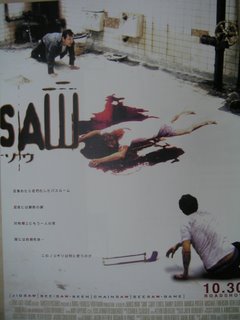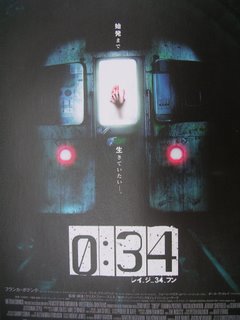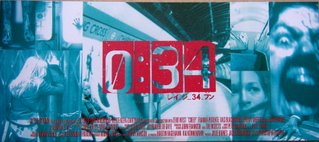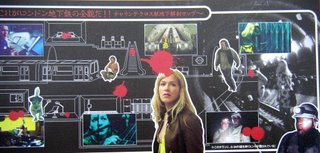The movie industry is, after all, a money-making business. They can talk for hours about art and beauty, and the important role of cinema in our society, but money is always on their minds. So every time they find a good trend (super heroes, disasters, mindless adventure) they set out to exploit the goldmine as thoroughly and ruthlessly as they can.
In the past few years I discovered what I'm sure is an involuntary trend, because I bet even the weirdest film executive would never decide to explore the theme of limb-cutting - at least consciously.
I wrote limb-cutting but I actually should say foot-cutting, because that's where all the wackos inhabiting movie-land seem to concentrate their attentions. The film that started it all - at least in my somewhat twisted mind - is the first installment of the Mad Max saga (1979). [WARNING - spoiler coming] At the end of the savage war between cops and bykers, Mel Gibson chains the boss of the bad guys to a gas-leaking wrecked car and hands him a saw. He has to cut his foot soon, because the car is going to explode. Those being perhaps slightly less deranged times, the byker doesn't have the balls to saw his foot off, and ends up in tiny pieces, while Gibson rides away in the sunset.
Fast forward to 2004 and the wife-cheating doctor chained in Saw can't wait for the cavalry to come and executes a "surgical operation" on the fly.



If you know your movie history and have broad enough tastes, you should know that the Japanese have always had a flair for the violent and bizarre. In recent years, director Takashi Miike has more than anybody else flown the flag of mind-boggling - sometimes stomach-revolting - cinema. Take, for instance, Audition (1999), a film few sane people have managed to sit through. It starts all sad and mellow with the tale of a widowed middle-aged man trying to re-marry; gets weirder and weirder with a series of increasingly unsettling scenes; and finally explodes in your face with one of the most frightening torture scenes you will ever see on screen. If you are too squimish DO NOT WATCH IT. If you have just stuffed your stomach full DO NOT WATCH IT. If you don't want to have nightmares DO NOT WATCH IT. Foot-cutting is, of course, included. As it is featured in a more recent offering by the same director, Koroshiya Ichi [Ichi the Killer] (2001). This one is a little less scary (at least in comparison to Audition, so be warned). and more flamboyant in its choice of imagery, often mixing the gruesome with a good dose of black humor (see the mafioso's hand turned into tenpura). But the foot-cutting is still there, this time very quick and climical.
Now that I think about it, Asian cinema seems to be particularly fond of such scenes. You can find another one in Antarctic Journal (2005), by Korean director Yim Pil-Sung.

This story of a doomed expedition in search of the geographical South Pole starts fairly well, but towards the end loses steam and falls apart. The best scenes are the ones in which the environment apparently takes a life of its own, as if the mass of snow and ice hid a Lovecraftian monster, ready to swallow those who dare challenge its kingdom.

The latest addition to this atrocity exhibition (as far as I know. Please send me more titles!) is the British flick Creep (2005) (0:34 in Japan) by Christopher Smith, the story of a beautiful chick who falls asleep while waiting for the last train and finds herself locked in the London Underground.

Even in this case - and in many other instances of horror / suspense flicks that have a good enough idea but don't know how to sustain it to the end - the story is very promising in the beginning, but gets more and more implausible. The appearance of the "monster", then, ruins everything (rule No.1: never show the monster too clearly; it is always disappointing). On the other side, the more the story gets boring and predictable, the bloodier it gets. Oh my! This one becomes very repulsive, and what's worse, uselessly repulsive. The monster - a crazy retarded maniac, actually - gets to play surgeon too. We don't actually see the cutting though. Thank you very much.


L'industria cinematografica e', lo sappiamo tutti, un business e in quanto tale punta al profitto. I produttori possono parlare per ore di arte ed estetica, e dell'importanza del cinema nella nostra societa', ma alla fin fine il loro chiodo fisso sono i soldi. Percio' ogni volta che scoprono un nuovo filone (supereroi, disastri, avventura stupida) lo sfruttano fino in fondo senza farsi tanti scrupoli. Negli ultimi anni ho scoperto quello che posso senz'altro definire un filone involontario, nel senso che non penso che un produttore - neanche il piu' strano di loro - deciderebbe di esplorare il tema delle amputazioni - almeno non consciamente.
Nel caso specifico di tratta di amputazioni di piedi e gambe. Eh si, sembra che tutti i maniaci che popolano il mondo del cinema si concentrino tutti su quelle parti del corpo. Il film che ha in un certo senso dato il via a questo filone - almeno secondo la mia memoria un po' bizzarra - e' Interceptor (1979) vale a dire il primo film della saga di Mad Max. [ATTENZIONE - adesso vi racconto come finisce] Al termine di una guerra selvaggia fra polizia e criminali in motocicletta, Mel Gibson incatena il capo della banda dei cattivi a una carcassa di macchina e gli porge una sega con la quale deve tagliarsi il piede. L'auto infatti perde benzina e sta per esplodere. Forse all'epoca esisteva ancora una certa decenza che impediva di mostrare certe cose, fatto sta che il cattivo non ha le palle per segarsi il piede e finisce in mille pezzi, mentre Gibson si allontana in moto nel tramonto. Spostiamoci rapidamente all'anno 2004 e il medico fedifrago di Saw non puo' aspettare che arrivino i nostri ed esegue una "operazione chirurgica" su due piedi. Anzi, su un piede solo.
Se conoscete un po' di storia del cinema e avete dei gusti un po' vari, dovreste sapere che i giapponesi hanno sempre avuto il gusto per la violenza e le bizzarrie. Di recente il regista Takashi Miike ha piu' di qualsiasi altra persona innalzato la bandiera del cinema piu' increbile, fantasioso e - diciamolo pure - rivoltante. Prendete, per esempio, Audition (1999), un film che poche persone sane di mente sono riuscite a vedere fino alla fine. Comincia con la storia triste e malinconica di un vedovo di mezza eta' che cerca di risposarsi; diventa sempre piu' strano con una serie di scene inquietanti; e alla fine ti esplode in faccia con una delle piu' terrificanti sequenze di tortura che avrete mai l'occasione di vedere sullo schermo. Se avete la pancia piena NON LO GUARDATE. Se non volete essere perseguitati dagli incubi NON LO GUARDATE. L'amputazione del piede fa naturalmente parte del menu'. E la si puo' vedere anche in un'opera piu' recente dello stesso autore, Koroshiya Ichi [Ichi il killer] (2001). Quest'ultimo e' un po' meno terribile (almeno in confronto a Audition, non dite poi che non vi avevo avvertito) e piu' fantasioso e "leggero" nella sua scelta di immagini, spesso mischiando il sangue a una buona dose do umorismo nero (come la mano del mafioso che si trasforma in un pezzo di tenpura). Ma l'amputazione c'e' sempre, anche se questa volta e' eseguito con gesto clinico e veloce.
Oa che ci penso, il cinema asiatico sembra amare particolarmente queste cose. Potete trovarne un altro esempio in Antarctic Journal (2005) del regista coreano Yim Pil-Sung. Questa storia di una tragica spedizione alla ricerca del Polo Sud geografico comincia piuttosto bene ma piu' si va avanti piu' diventa farraginosa e cade a pezzi. Le scene migliori sono quelle in cui l'ambiente naturale sembra prendere vita propria, come se la massa di neve e ghiaccio nascondesse un mostro lovecraftiano pronto a ingoiare tutti coloro che lo sfidano.
L'ultima aggiunta a questa fiera delle atrocita' (almeno per quello che ne so io. Per favore mandatemi altri titoli!) e il film inglese Creep (2005) del regista Christopher smith, la storia di una bella bionda che si addormenta mentre aspetta l'ultimo treno per tornare a casa e quando si risveglia si ritrova chiusa dentro una stazione della metropolitana di Londra. Anche in questo caso - come spesso succede in molti film dell'orrore che nascono da un'idea originale ma poi non riescono a sostenerla fino in fondo - la storia promette bene ma diventa sempre piu' implausibile man mano che si va avanti. L'apparizione del "mostro", poi, rovina tutto (regola n.1: mai fare vedere il mostro troppo chiaramente: e' sempre una delusione). D'altra parte piu' la storia diventa noiosa e prevedibile, piu' scorre il sangue. Mamma mia santissima! Questo film riesce a diventare veramente repellente. Il mostro - che in realta' e' "solo" un maniaco pazzo - gioca pure al dottore. Pero' questa volta non ci mostrano chiaramente il lavoro di sega. Grazie mille.
No comments:
Post a Comment